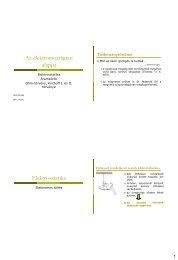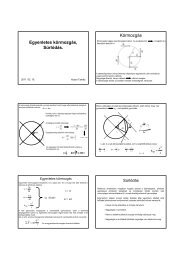Electromagnetic spectrum and the LASER
Electromagnetic spectrum and the LASER
Electromagnetic spectrum and the LASER
Create successful ePaper yourself
Turn your PDF publications into a flip-book with our unique Google optimized e-Paper software.
<strong>Electromagnetic</strong> <strong>spectrum</strong> <strong>and</strong><br />
<strong>the</strong> <strong>LASER</strong><br />
September 2011<br />
Zoltán Ujfalusi<br />
University of Pécs, Faculty of Medicine,<br />
Dept. Biophysics<br />
Scientists<br />
physicists, chemists, astronomers<br />
• Sir Isaac Newton<br />
• Sir William Herschel<br />
• Johann Wilhelm Ritter<br />
• Joseph von Fraunhofer<br />
• Robert Wilhelm Bunsen<br />
• Gustav Robert Kirchhoff<br />
• Albert Einstein<br />
• Louis-Victor de Broglie<br />
• James Clerk Maxwell<br />
• Heinrich Rudolf<br />
- dispersion (1664)<br />
- IR (1800)<br />
- UV (1801)<br />
- lines in <strong>the</strong> solar spectra (1814)<br />
- interpretation of lines (1861)<br />
- interpretation of lines (1861)<br />
- light quantum (photon) (1904)<br />
- matter-waves (1924)<br />
- EM radiation <strong>the</strong>oretically (1864)<br />
- EM radiation pragmatically (1888)<br />
Huygens-Fresnel principle<br />
1. All points on a wave front can be considered as<br />
point sources for <strong>the</strong> production of spherical<br />
secondary wavelets.<br />
2. The interference of <strong>the</strong> secondary wavelets<br />
determines <strong>the</strong> fur<strong>the</strong>r behaviour of <strong>the</strong> wave.<br />
Transversal<br />
wave<br />
E<br />
B<br />
x<br />
x<br />
The light<br />
<strong>Electromagnetic</strong> wave<br />
magnetic field<br />
strength- vector<br />
electric field strength -<br />
vector<br />
wavelength<br />
The vectors of <strong>the</strong> electric <strong>and</strong> <strong>the</strong> magnetic gradients<br />
are perpendicular to each o<strong>the</strong>r <strong>and</strong> to <strong>the</strong> direction of<br />
<strong>the</strong> propagation of <strong>the</strong> wave.<br />
• James Clerk Maxwell (1864)<br />
verified <strong>the</strong>ir existence <strong>the</strong>oretically.<br />
• Heinrich Rudolf (1888) confirmed<br />
<strong>the</strong>ir existence experimentally.<br />
Interaction of <strong>the</strong> light with matter<br />
• Quanted energy uptaking (photon)<br />
• Interaction of electromagnetic wave<br />
with atomic system (matter):<br />
• reflection<br />
• absorption<br />
• transmission<br />
• (scattering)<br />
1
The dual nature of <strong>the</strong> light<br />
Wave<br />
(propagation)<br />
• Diffraction<br />
• Interference<br />
• Polarization<br />
Particle<br />
(interaction)<br />
• photoeffect<br />
• Compton-effect<br />
Albert Einstein (1905) : photoelectric effect<br />
photon (light quantum), its energy: E = h·n (or E = h·f)<br />
Louis-Victor de Broglie (1924) : Matter-waves <strong>the</strong>ory<br />
(All materials have wave nature as well.)<br />
λ = h/p, where p is <strong>the</strong> impulse => λ = h/m·v<br />
Polarization<br />
Important physical quantities <strong>and</strong><br />
relations<br />
Frequency: n (1/s)<br />
Wavelength:<br />
� (m)<br />
Wavenumber: n (cm-1 )<br />
c<br />
v<br />
1<br />
�<br />
Energy: E (J) h . n<br />
Extinct. coeff.:� (M -1 cm -1 or (mg/ml) -1 cm -1 )<br />
a<br />
Interference<br />
�x � s � s � a�<br />
sin�<br />
1<br />
2<br />
Einstein: energy of a photon (light-quantum)<br />
To achieve max. gain: To achieve max. weakening:<br />
1<br />
a� sin� � n�<br />
� a�<br />
� � ( n � ) ��<br />
sin 2<br />
Linearly polarized light<br />
2
Praya dubia<br />
Joseph von Fraunhofer<br />
(1787–1826)<br />
Types of <strong>the</strong> luminescence<br />
Bathocyroë<br />
Atolla vanhoeffeni<br />
Line spectra (emission) of some elements<br />
He<br />
Hg<br />
Na<br />
Ne<br />
Ar<br />
<strong>LASER</strong> HISTORY IN A NUTSHELL<br />
Light Amplification by Stimulated Emission of Radiation<br />
1917 - Albert Einstein: <strong>the</strong>oretical prediction of stimulated emission<br />
1946 - G. Meyer-Schwickera<strong>the</strong>r: first eye surgery with light<br />
1950 - Arthur Schawlow <strong>and</strong> Charles Townes: emitted photons may be in <strong>the</strong><br />
visible range<br />
1954 - N.G. Basow, A.M. Prochorow, <strong>and</strong> C. Townes: ammonia maser<br />
1960 - Theodore Maiman: first laser (ruby laser)<br />
1964 - Basow, Prochorow, Townes (Nobel prize): quantum electronics<br />
1970 - Arthur Ashkin: laser tweezers<br />
1971 - Dénes Gábor (Nobel prize): holography<br />
1997 - S. Chu, W.D. Phillips <strong>and</strong> C. Cohen-Tanoudji (Nobel prize): atom cooling<br />
with laser<br />
3
E 2<br />
r(n)<br />
E 1<br />
Laser principles I. Stimulated emission<br />
Elementary radiative processes:<br />
1. Absorption 2. Spontaneous emission 3. Stimulated emission<br />
B 12<br />
•Frequency of transition:<br />
n 12=N 1B 12r(n)<br />
•�E= E 2-E 1=hn<br />
energy quantum<br />
is absorbed.<br />
N 2<br />
N 1<br />
Explanation: two-state atomic or molecular system<br />
E 1, E2 : energy levels, E2>E1<br />
r(n) : spectral power density of external field<br />
N 1, N2 : number of atoms, molecules on <strong>the</strong> given energy level<br />
B 12, A21, B21: transition probabilities between energy levels (Einstein coefficients), B12 = B21<br />
A 21<br />
•Frequency of transition:<br />
n 21=N 2A 21<br />
•E 2-E 1 photons<br />
radiate independently<br />
in all directions.<br />
r(n)<br />
B 21<br />
•Frequency of transition:<br />
n 21=N 2B 21r(n)<br />
•Upon external stimulation.<br />
•Field energy increases.<br />
•Phase, direction <strong>and</strong><br />
frequency of emitted <strong>and</strong><br />
external photons are identical.<br />
Laser principles III. Optical resonance<br />
End mirror<br />
Pumping<br />
Active medium<br />
d=n�/2<br />
Partially<br />
transparent mirror<br />
Resonator:<br />
•two, parallel planar (or concave) mirrors<br />
•Couples part of <strong>the</strong> optical power back in <strong>the</strong> active medium<br />
•Positive feedback -> self-excitation -> resonance<br />
Types of laser<br />
Based on active medium:<br />
1. Solid state lasers<br />
Crystals or glasses doped with metal ions; Ruby, Nd-YAG, Ti-zaphire<br />
Red - infrared spectral range; CW, Q-switched modes, high power<br />
2. Gas lasers<br />
Best known: He-Ne laser (10 He/Ne). Small energy, wide use<br />
CO 2 laser: CO 2-N 2-He mixture; �~10 µm; enormous power (100 W)<br />
Laser beam<br />
3. Dye lasers<br />
Dilute solution of organic dyes (e.g., rhodamine, coumarine); pumped with ano<strong>the</strong>r laser<br />
Large power (in Q-switched mode); Tunable<br />
4. Semiconductor lasers<br />
No need for resonator mirrors (internal reflection)<br />
Red, IR spectral range. Large CW power (up to 100 W)<br />
Beam characteristics not ideal. Wide use due to small size.<br />
Laser principles II. Population inversion<br />
•Amplification depends<br />
on <strong>the</strong> relative population<br />
of energy levels<br />
E 1<br />
E 0<br />
A<br />
F<br />
Active<br />
medium F+dF<br />
dz<br />
Thermal equilibrium Population inversion<br />
•Population inversion only<br />
in multiple-state systems!<br />
•Pumping: electric,<br />
optical, chemical energy<br />
1. Small divergence<br />
Parallel, collimated beam<br />
E 2<br />
Pumping<br />
E 0<br />
E 1<br />
E 0<br />
E 1<br />
Fast relaxation<br />
Metastable state<br />
Properties of laser<br />
2. High power<br />
In continuous (CW) mode: tens, hundreds of watts (e.g., CO 2)<br />
Q-switched mode: instantaneous power is enormous (GW)<br />
Large spatial power density due to small divergence<br />
3. Small spectral width<br />
“Monochrome”<br />
Large spectral power density<br />
4. Polarized<br />
5. Possibility of very short pulses<br />
ps, fs<br />
Laser transition<br />
6. Coherence<br />
phase equivalence, ability for interference<br />
Temporal coherence (phase equivalence of photons emitted at different times)<br />
Spatial coherence (phase equivalence across beam diameter)<br />
4


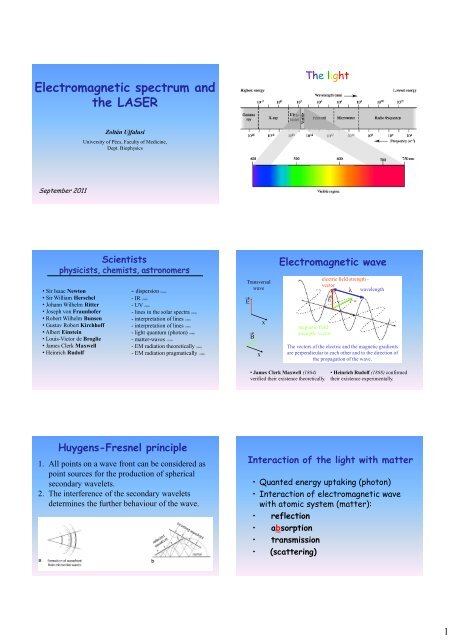
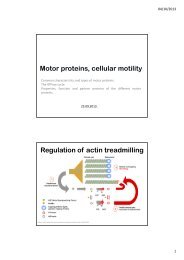
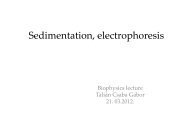
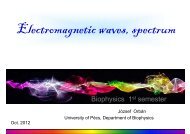

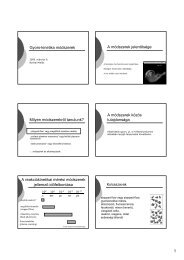


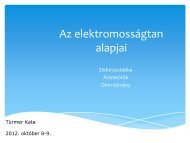



![Microsoft PowerPoint - Intermedier filamentumok [Kompatibilis m\363d]](https://img.yumpu.com/17119137/1/190x135/microsoft-powerpoint-intermedier-filamentumok-kompatibilis-m363d.jpg?quality=85)
